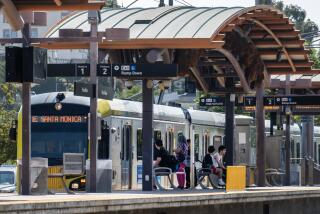Major Step In Program Is Just Getting to Work : Education: Part of disabled students’ training is using public transportation to get to the job.
- Share via
LONG BEACH — Transportation can be a stumbling block that prevents mentally disabled teen-agers and young adults from getting jobs.
One goal of the Long Beach Unified School District’s Program Workability, which trains disabled students for jobs, is to teach the students how to get to and from work on public transportation.
“All of their lives they have been picked up by a big yellow school bus and taken to school and then taken home on that same bus,” said Kathleen Elkins, who heads the program. “But if they are going to work, they are going to have to learn to take a public bus.”
The parents who fear for their children’s safety are the first obstacle that must be overcome, Elkins said.
“That’s understandable, because their children have always been in a safe, controlled environment and we want to put them out there alone in the city, and that’s scary,” said Elizabeth Campbell, the district’s vocational education counselor for special education.
“We always took him everywhere,” said Concepcion Flores, whose 22-year-old son Juan is a Workability graduate. “We were afraid. What would happen if he got lost?”
The specific training given to a mentally disabled student depends on the individual’s skills, Campbell said, but there are some basics.
First, students are given identification cards that explain their disabilities and tell who should be called if a lost student is found.
Trainers are then assigned to students who will ride to work with them for several weeks.
“Even though many of the students have lived in Long Beach for a long time, they don’t know how to get anywhere because they have never had to get there themselves,” Campbell said. “It’s like if you or I always ride with somebody someplace and then we have to drive there ourselves. We can get lost.”
The trainer introduces the student to the drivers who are normally on the route so they will know that the student may need help.
“We want our bus operators to be understanding and sensitive to riders who have special needs,” said Guy Heston, assistant general manager of Long Beach Transit, the city’s bus line. “We ask them to seat the special riders up front so the driver can tell them when they have reached their stop and give them any extra help they need.”
Photographs are also taken of landmarks that are at the bus stop where the student is to exit and given to the student to help them recognize it, Campbell said.
When the student is finally allowed to ride the bus alone, the trainer for several days follows the bus in a car to make sure the student arrives at work safely, Campbell said.
If that goes well, the student is allowed to solo.
No student has ever been lost for more than a few hours, Campbell said, and none has been harmed.
“Even after they told me Juan could ride the bus, I would go to his work every day and sit there to make sure he got there OK,” Flores said. “And when a bus would come and he didn’t get off, I would grow nervous. But every day he got there. So now I don’t worry, at least too much.”
More to Read
Sign up for Essential California
The most important California stories and recommendations in your inbox every morning.
You may occasionally receive promotional content from the Los Angeles Times.













